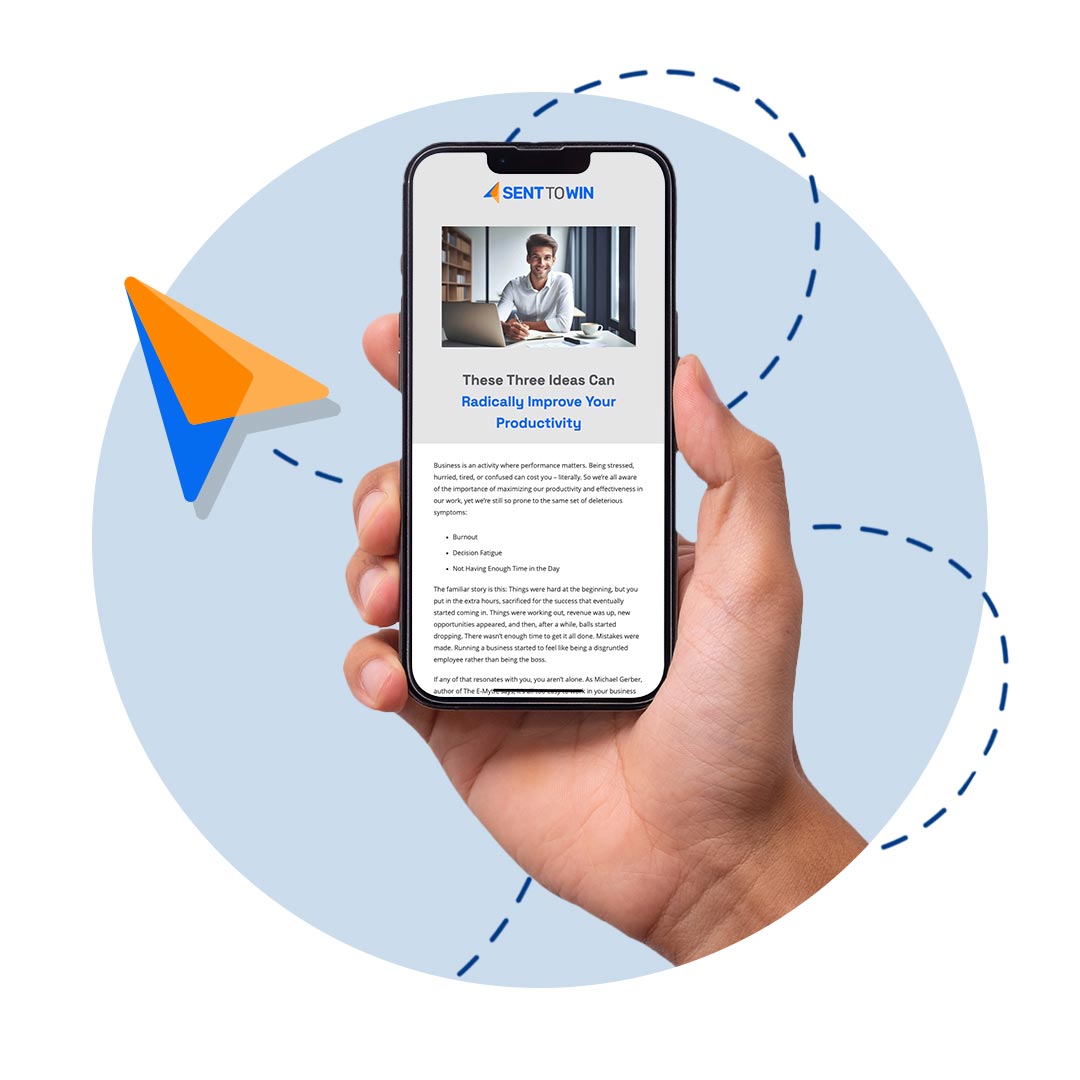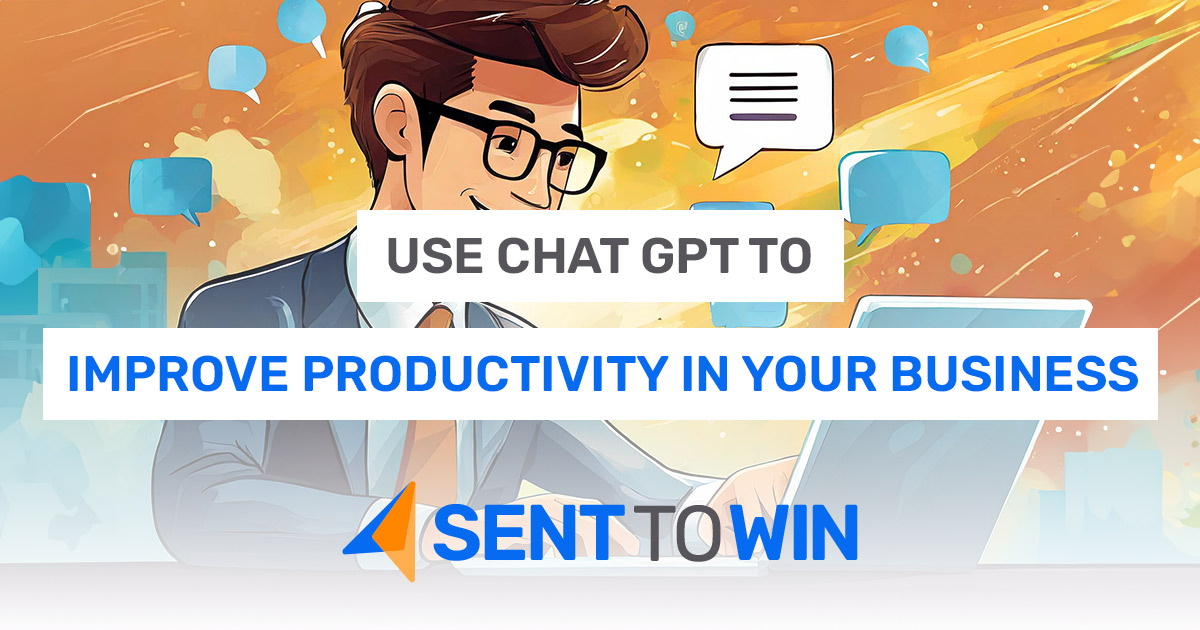Use Chat GPT to Improve Productivity in Your Business
Large Language models, such as Chat GPT, are very new, changing rapidly, and suddenly dominant in the world of work, leaving many small businesses and leaders unsure as to how they should be thinking about this new development. Are robots replacing people? (Kind of, but not really) Does this mean all my problems are solved? (No) Is this going to revolutionize how we do business in this society? (Probably)
But if we can wade through the apocalyptic warnings, the overly optimistic hyperboles, and find a pragmatic, reasonable stance, ambitious people stand to gain tremendously from the arrival of this technology. AI is a force multiplier for modern entrepreneurs and high-powered employees, and, if you know how to use it, it can catapult you ahead of the competition.
To that end, we’ll be giving a few specific applications of Chat GPT that you can use in your business to save time, improve profitability, efficiency, and quality, with specific prompts to guide you.
Product Development
Chat GPT is excellent at quickly giving you a place to start on any topic. You might not agree with its output 100%, but critiquing something that is mostly right – and exists – is significantly easier than creating something from nothing. Chat GPT jumps you past the time-consuming first step.
Consider something like new product development. You want to understand who your customer is, and ideally develop an avatar to understand who they are and how to reach them.
Take a look at what Chat GPT put out in only a few seconds to the prompt, “Create a customer profile for a mid-size SUV in the $40,000 – $55,000 range.”
Customer Profile: Mid-Size SUV ($40,000 – $55,000 Range)
Demographic Information:
- Age: 30-50 years old
- Income: $80,000 – $120,000 annually
- Family Status: Primarily families with 2 or more members, or individuals who value spacious interiors.
- Occupation: Middle to upper-middle-class professionals, possibly with managerial or executive positions.
- Location: Suburban or urban areas with a mix of commuting needs and recreational activities.
Lifestyle and Values:
- Family-Oriented: Places a high value on safety features and spacious interiors for family outings.
- Active Lifestyle: Enjoys outdoor activities such as camping, hiking, or sports, requiring a vehicle capable of handling various terrains.
- Tech-Savvy: Appreciates advanced technology features and connectivity options for both entertainment and convenience.
- Eco-Conscious: May show interest in fuel efficiency or hybrid options, reflecting a concern for the environment.
- Status Symbol: Views the SUV as a symbol of success and practicality, balancing style with functionality.
Usage Patterns:
- Daily Commute: Regularly commutes to work or drives children to school, requiring a comfortable and reliable vehicle.
- Recreational Adventures: Takes weekend trips for outdoor activities, necessitating sufficient cargo space and towing capabilities.
- Road Trips: Enjoys extended road trips for vacations, making fuel efficiency and comfort crucial considerations.
Vehicle Preferences:
- Size and Space: Prefers a mid-size SUV for a balance between maneuverability and ample interior space.
- Safety Features: Prioritizes advanced safety technologies, such as collision avoidance systems, adaptive cruise control, and lane-keeping assistance.
- Comfortable Interiors: Values premium materials, comfortable seating, and a quiet cabin for a pleasant driving experience.
- Technology Integration: Appreciates a user-friendly infotainment system, smartphone integration, and advanced driver-assistance features.
- Towing Capacity: May require towing capabilities for trailers, boats, or other recreational equipment.
Brands and Models Considered:
- Toyota Highlander: Known for reliability, safety features, and a spacious interior.
- Ford Explorer: Offers a balance of performance, technology, and towing capacity.
- Honda Passport: Combines off-road capability with a comfortable ride for adventurous families.
- Chevrolet Traverse: Provides ample cargo space and a smooth ride for long journeys.
- Hyundai Palisade: Offers a luxurious feel, advanced safety features, and technology integration.
This customer profile is a generalization, and individual preferences may vary. The mid-size SUV market is diverse, and customers may prioritize different features based on personal needs and preferences. Is any of what it put out rocket science? Not really, but it is what you used to have to assign a person to report back to you on, a task of at least a couple of hours in some cases. This output focuses on the key aspects of your target market that you need to keep in mind, allowing you to build and customize the work from there.
Or suppose you are designing a new product, tweaking an existing one, or trying to solve problems in an existing service space. Chat GPT, which has been trained on huge amounts of data online, can draw on the patterns of people’s pain points in various situations or with various products.
Take a look at its answer to the prompt: “What are the most common complaints fast-food customers report?”
Common complaints from fast-food customers can vary, but some recurring issues include:
1. Accuracy of Orders:
- Incorrect items or missing items in the order.
- Mistakes in customization requests, such as wrong toppings, sauces, or modifications.
2. Service Speed:
- Slow service or long wait times in drive-thrus or at the counter.
- Delayed food preparation leading to cold or stale food.
3. Food Quality:
- Poorly cooked or undercooked food.
- Food that doesn’t meet freshness expectations.
4. Cleanliness and Hygiene:
- Dirty or unsanitary dining areas, restrooms, or food preparation areas.
- Reports of employees not following proper hygiene practices.
5. Customer Service:
- Rude or unhelpful staff.
- Issues with communication or lack of clarity when addressing concerns.
6. Price and Value:
- Perceived high prices for the quality and quantity of food.
- Inconsistencies in portion sizes.
7. Limited Menu Options:
- Complaints about a lack of variety or dissatisfaction with available menu options.
- Limited or inconsistent availability of specific menu items.
8. Technical Issues:
- Malfunctioning or slow ordering systems, both in-store and through mobile apps.
- Payment processing issues causing delays.
9. Packaging Problems:
- Inadequate or messy packaging leading to spills or leaks.
- Environmental concerns related to excessive packaging.
10. Temperature Issues:
- Food being served at incorrect temperatures, either too hot or too cold.
- Inadequate packaging leading to loss of heat or freshness during delivery.
Helpful, no? Maybe you can comb through the most common complaints, served up for your immediate perusal, and figure out where you can out-work the competition, or how to position yourself in the market.
Basically, you’ll want to treat Chat GPT like an intern or an entry-level employee to whom you would assign research tasks, brainstorming, and pitch work. The results are instant, and they don’t cost a dime.
Analysis and Data Mining of Proprietary Information
The only problem with the prompts and output listed in the previous section is that they rely on generally available information. What if your company has a whole database of industry-specific customer behavior, past purchases, or other relevant, specialized information? You can’t exactly paste 5,000 pages of spreadsheets into Chat GPT. So how do you harness the powerful analytic capability of this technology for your business?
Earlier this year, Open AI (Chat GPT’s parent organization) released something they’re calling “GPTs,” which allows businesses and individuals to customize and train a personalized GPT on specific data and parameters. This isn’t free, like regular Chat GPT, but it isn’t very expensive either. All you need is a Chat GPT Plus account (currently $20/month), and then you’ll have to navigate to chat.openai.com/create.
From there, it’ll take a little bit of work to train and fine-tune your model, but it may well be worth your time to do so.
Check out a step-by-step guide here to help you along the way.
SEO, Split-Testing, and Keyword Performance
If you’ve ever gotten a headache when someone said the words, “Search Engine Optimization,” Chat GPT could be a big help to you. In today’s digital marketplace, crafting a message that actually gets in front of people can be a tricky task for the uninitiated. But if you want to drive traffic to your website or improve the performance of your online ads, ask the language model for suggestions.
Try the prompt, “Suggest keywords to improve SEO on content for a website that sells _________.” Within moments, you will have a list of keywords and phrases that you need to incorporate into your content – and you should probably be bidding for those keywords via Google Adwords – to increase traffic to your site.
Additionally, Chat GPT is great at suggesting high-performing phrases to use in marketing copy, as well as variations on verbiage so you can split-test ads and select what works the best. Try prompting it with, “What are the best-performing phrases in online ________ advertisements,” or, try asking it, “Give me two variations of the following ad copy for the purpose of split-testing:” (and then list your original ad copy in quotation marks).
When I tried this out, I didn’t spend a lot of time coming up with great copy to use as an example, admittedly, but it is notable that the variations Chat GPT came up with were, well, better.
My original, made-up ad copy (and don’t judge me):
“Bongo’s Sunglasses are now just 2 for $50! Keep your eyes safe from harmful UV rays, and then go have fun in the sun!”
Chat GPT’s two variations:
“Unbeatable Deal! Grab two pairs of Bongo’s Sunglasses for just $50! Shield your eyes from harmful UV rays while you soak up the sun in style!”
“Sunny Savings Alert! Score 2 pairs of Bongo’s Sunglasses at an incredible $50! Safeguard your eyes from UV rays and elevate your sunny adventures with fashion-forward shades!”
Trust, but Verify
One final word of caution: Chat GPT can be amazingly helpful and can improve your analysis, efficiency, and productivity inside your business, but the technology is far from perfect. Despite the name, publically available artificial intelligence projects are actually not intelligent at all. They essentially use predictive text mechanisms to constantly guess the next right word to answer your prompt. That means, for whatever reason, sometimes these models “hallucinate,” and completely make something up. A lawyer in New York, for example, recently had to pay a fine for submitting false legal citations in a case, because though he was using Chat GPT to help him research, he did not verify its output, landing him in hot water. On the visual side of things, this is like when you ask Dall-E (an AI image generator) to create a picture of a man eating pizza or spaghetti, and, well, things get weird.
Stuart Russel, an artificial intelligence expert at UC Berkley, gave some stern warnings to businesses who would wholesale replace individual workers with unverified work from Chat GPT, so it’s worth taking his caution about bugs in the system seriously. However, if you keep a careful eye on the output, and look over everything it spits out at you before blindly passing it along, Chat GPT can save you a lot of time, money, and headaches.
How can you leverage Chat GPT in your business? Try the prompts we’ve suggested in this article, and then spend a little time playing around with the software to see how it can most benefit you and your work.
Quick Hits
- China is now the #1 exporter of cars worldwide.
- Samsung expects to post a 35% drop in profits for Q4, falling short of expectations.
- Religion News Service cites data to say Americans are becoming less spiritual and less religious.
- Christian colleges around the country experiment with various “free-tuition” models.
For Kingdom Leaders, By Kingdom Leaders
Bringing Kingdom-minded leaders like you fresh perspectives and insights on business, finance, and leadership trends.




